Contents at a Glance
Contents
About the Authors
About the Technical Reviewers
Acknowledgments
Foreword
Introduction
Chapter 1: Introduction
What Is Embedded Firmware?
Where Is Firmware?
What Do Firmware Engineers Do?
Firmware Preparation for New Hardware
The Mystery of Bits
Programming Guides
The Intel® Firmware Support Package
The Uniqueness of Embedded Firmware
The Choice of Firmware Stacks
Welcome to the Era of the Internet of Things
Technical Coverage in This Book
The Future of Firmware
Chapter 2: Firmware Stacks for Embedded Systems
Is a One-Size-Fits-All Solution Possible?
Microkernel
Real-Time Operating S ystem (RTOS)
Legacy BIOS
Implementations of the UEFI Framework
Open Source Firmware Stacks
Proprietary Firmware Stacks
Make o r Buy
The Advantages of Outsourcing
The Disadvantages of Outsourcing
In-House Development
Summary
Chapter 3: Intel® Firmware Support Package (Intel® FSP)
The Intel FSP Philosophy
What Is in Intel FSP?
Intel FSP Binary Format
Sample Boot Flow
Locating the Entries of Intel FSP
The Hard Way to Find Intel FSP APIs: Use Data Structure
The Easy Way to Find FSP APIs: Use Hard-Coded Constants
Programming Interface: The APIs of Intel FSP
TempRamInit
FspInitEntry
NotifyPhase
Intel FSP Output
API Execution Status
Temporary Memory Data HOB
Non-Volatile Storage HOB
Sample Code for Parsing HOBs
Customization of Intel FSP
Downloading Intel FSP
Microcode Patches
Relocating Intel FSP
Integration and Build
The Future of Intel FSP
What Is Coming in the Following Chapters
Chapter 4: Building coreboot with Intel FSP
The Introduction of coreboot
The Philosophy of coreboot
A Brief History
v1: 1999–2000
v2: 2000–2005
v2+: 2005–2008
v3: 2006–2008
2008 LinuxBIOS Renamed “coreboot”
v4: 2009–2012
v4+: 2012–2014
Further Reading
Prerequisites for Working with coreboot
Community Organization
Git and Gerrit
Git Commit Messages
coreboot Sign-off Procedure
Developer’s Certificate of Origin 1.1
Adding Your Sign-off
Working with the coreboot Community
coreboot Do’s
coreboot Don’ts
Nonsource Binaries in coreboot
A Hands-on Example: Building coreboot for the MinnowBoard MAX Mainboard
Environment
Hardware: MinnowBoard MAX
MinnowBoard MAX Platform Details
Development Directory
Downloading Intel FSP
Installing Intel FSP
Downloading the coreboot Source
coreboot Toolchain
coreboot Commit Hooks
Creating a coreboot Development Branch
Building the Mainboard
On the Menuconfig Menu
On the Chipset Menu
On the Devices Menu
Build
Summary of Commands
Flashing the ROM
Preparing the Flash Programmer
Flashing the ROM Image
coreboot Internals
Boot Stages
Additional Files
CBFS
An Example of CBFS
CBFS Size
Special Binaries
Boot Flow Using Intel FSP
Reset Vector and Bootblock
romstage
ramstage
Payload
coreboot Source
coreboot Device Tree
Chips and Devices
Device Tree Variables
A Device Tree Example
Chip Operations
Device Operations
coreboot Hardwaremain State Machine
State Machine States
State Machine Callbacks
Mainboard
The Chipset Driver
Chipset FSP UPD Options
The FSP Driver
Kconfig
xcompile
Payloads
SeaBIOS
GRUB 2
FILO
iPXE
TianoCore
Depthcharge
U- Boot
Memtest86+
libpayload
coreboot Troubleshooting and Debugging
Postcodes
Serial Debug
EHCI USB Debug
Summary
Chapter 5: Chrome book Firmware Internals
About Chrome book and Chrome OS
Chrome OS Firmware Overview
Chrome OS Security Philosophy
Chrome OS Security Guiding Principles
Power wash
Chrome OS Boot Modes
Verified (Normal) Mode
Recovery Mode
Developer Mode
Chrome OS Coreboot
x86
ARM
Depth charge Payload
libpayload
Verified Boot
Verified Boot and Kernel Security
Chrome OS Firmware Boot Log
Boot Times Log
Chrome OS Firmware Event Log
Google SMI Linux Kernel Driver
Chrome OS Extensions to the Firmware Image
FMAP
BOOT_STUB FMAP Section
Chrome OS Firmware RW FMAP Sections
An fmap.dts (RW_SECTION_A) Example
Google Binary Block (GBB)
GBB: HWID v3
GBB: Firmware Bitmaps
GBB: Firmware Keys
GBB: Boot Flags
Vital Product Data ( VPD)
Firmware TPM Usage
Chrome OS Firmware Update
Chrome OS Utilities
flashrom
gbb_utility
GBB Flags Utility Script: set_gbb_flags.sh
crossystem
mosys
Google Embedded Controller
Power Sequencing
Battery Charging
Thermal Management
Keyboard Controller
Other Peripheral Controls
Chrome EC Software Sync
Software Sync Steps
Summary
Chapter 6: Intel FSP and UEFI Integration
Introduction to EFI
Introduction to FSP
Introduction to EDK II
Summary
FSP Components
FSP Wrapper Boot Flow
Generic FSP Wrapper Boot Flow
Normal Boot
Boot Flow
Memory Layout for a Normal Boot Flow
FSP Normal Boot Data Structure
S3 Boot
Boot Flow
S3 Memory Layout
S3 NV Data Passing
Capsule Flash Update
Boot Flow
Capsule Update Memory Layout
Recovery Boot Flow
FSP Recovery Memory Layout
coreboot Payload Based upon EDK II
Building Minnow and MinnowMax with FSP
Future of the Intel FSP
Conclusion
Chapter 7: Building Firmware for Quark Processors
Overview of UEFI and PI
History of Implementations and Specifications
Introduction to EDK II Building Blocks
PKG: Packaging
MdePkg
MdeModulePkg
IntelFrameworkPkg
IntelFrameworkModulePkg
Packages
PCD: Platform Configuration Database
Syntax
DEC: Platform Declaration File
Syntax
DSC: Platform Description File
FDF: Flash Description File
Syntax
Build: The EDK II Build Command
INF: INF File
More Information
Introduction to the EDK II Subset
Introduction to Quark
ROM Flash Image Size Optimization
Fixed Resource
DRAM/SMRAM
Remove Features
Reduce Features
Compiler Options
Build Options
Results of the TinyQuark Optimization
RAM Footprint Optimization
Optimization
Result of Memory Usage Optimization
Conclusion
Chapter 8: Putting It All Together
RTOS and Intel FSP
Intel FSP and Open Source Philosophy
Customization and Production of Intel FSP
It Is a Community Effort After All
Appendix A: Sample Boot Setting File (BSF)
Index
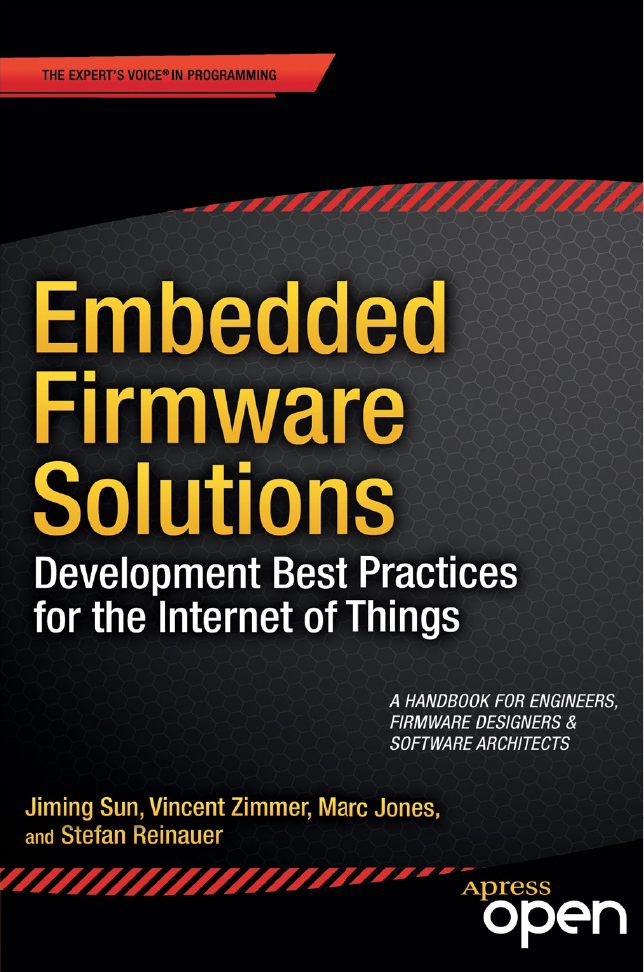



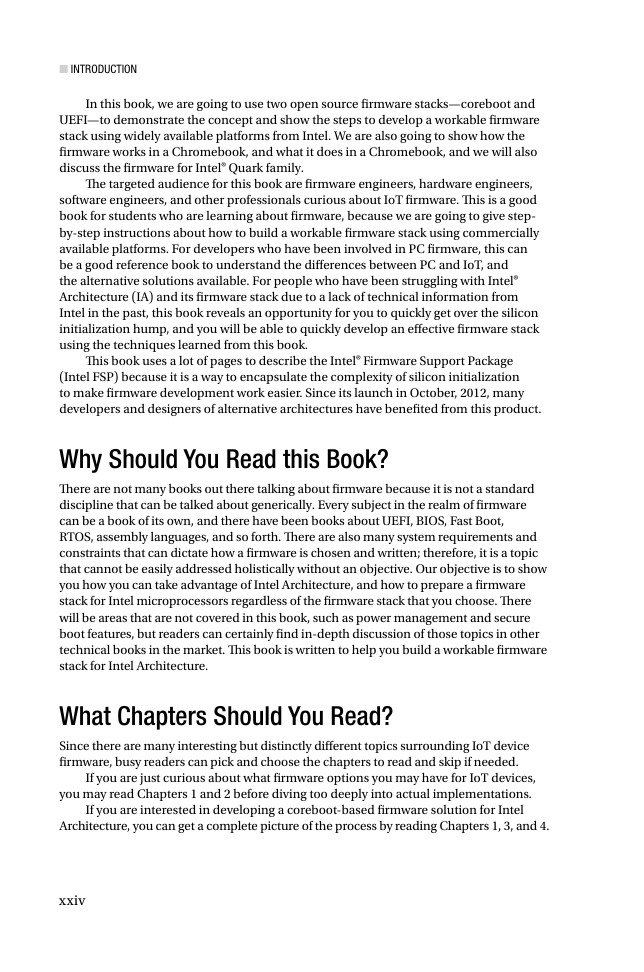
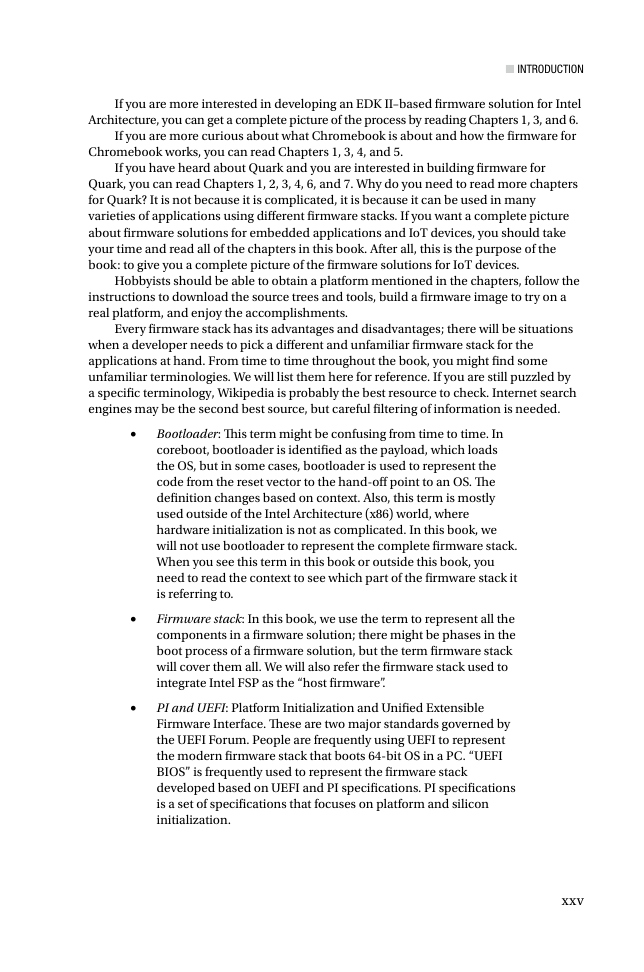
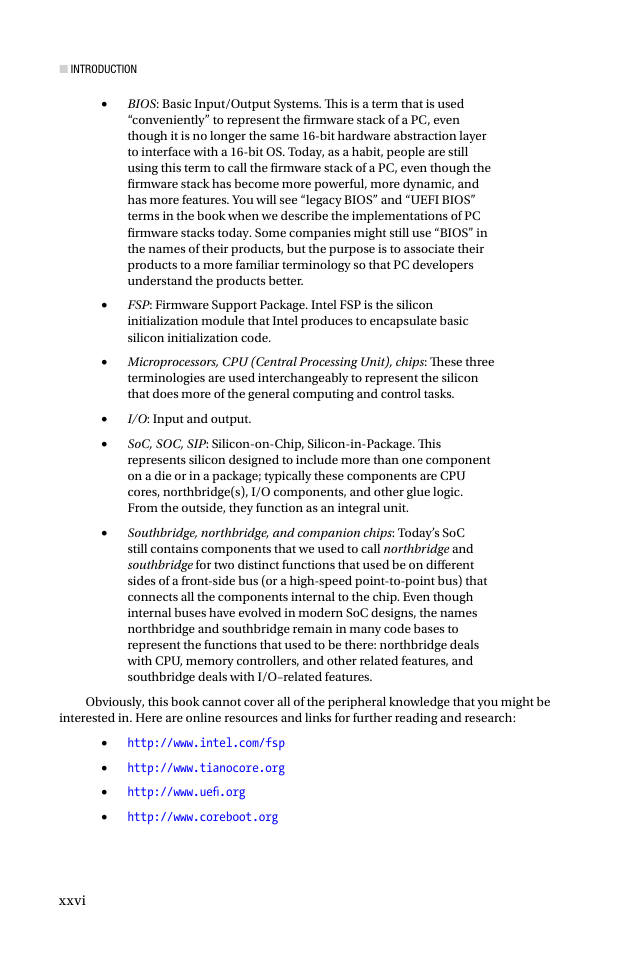
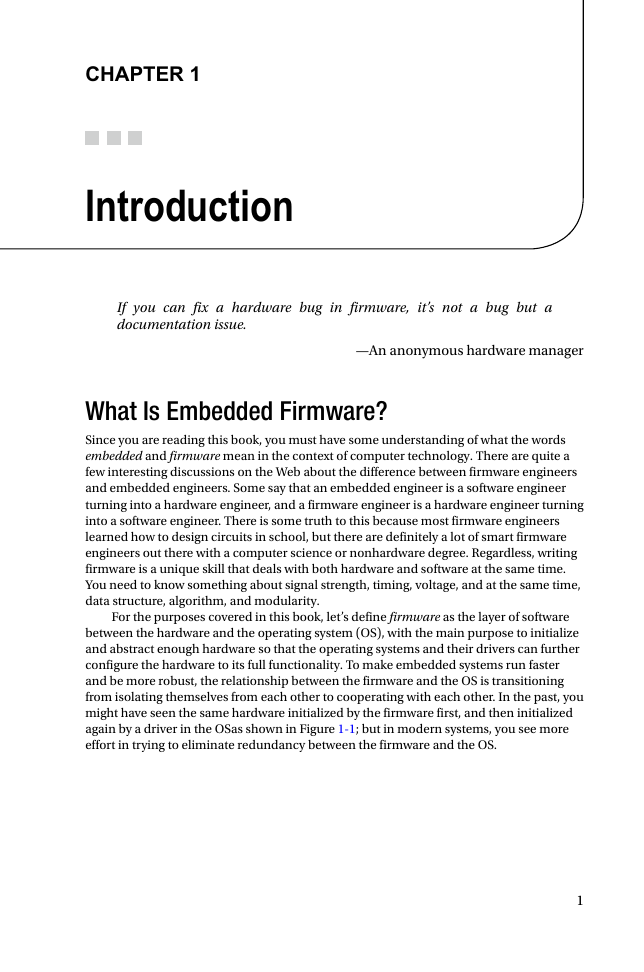








 2023年江西萍乡中考道德与法治真题及答案.doc
2023年江西萍乡中考道德与法治真题及答案.doc 2012年重庆南川中考生物真题及答案.doc
2012年重庆南川中考生物真题及答案.doc 2013年江西师范大学地理学综合及文艺理论基础考研真题.doc
2013年江西师范大学地理学综合及文艺理论基础考研真题.doc 2020年四川甘孜小升初语文真题及答案I卷.doc
2020年四川甘孜小升初语文真题及答案I卷.doc 2020年注册岩土工程师专业基础考试真题及答案.doc
2020年注册岩土工程师专业基础考试真题及答案.doc 2023-2024学年福建省厦门市九年级上学期数学月考试题及答案.doc
2023-2024学年福建省厦门市九年级上学期数学月考试题及答案.doc 2021-2022学年辽宁省沈阳市大东区九年级上学期语文期末试题及答案.doc
2021-2022学年辽宁省沈阳市大东区九年级上学期语文期末试题及答案.doc 2022-2023学年北京东城区初三第一学期物理期末试卷及答案.doc
2022-2023学年北京东城区初三第一学期物理期末试卷及答案.doc 2018上半年江西教师资格初中地理学科知识与教学能力真题及答案.doc
2018上半年江西教师资格初中地理学科知识与教学能力真题及答案.doc 2012年河北国家公务员申论考试真题及答案-省级.doc
2012年河北国家公务员申论考试真题及答案-省级.doc 2020-2021学年江苏省扬州市江都区邵樊片九年级上学期数学第一次质量检测试题及答案.doc
2020-2021学年江苏省扬州市江都区邵樊片九年级上学期数学第一次质量检测试题及答案.doc 2022下半年黑龙江教师资格证中学综合素质真题及答案.doc
2022下半年黑龙江教师资格证中学综合素质真题及答案.doc